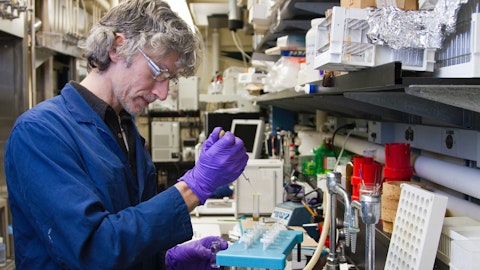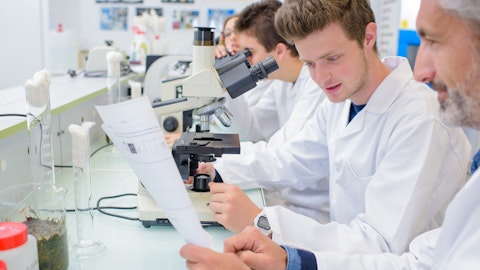Stepan Company (NYSE:SCL) Q3 2023 Earnings Call Transcript October 18, 2023
Stepan Company misses on earnings expectations. Reported EPS is $0.64 EPS, expectations were $0.82.
Operator: Good day, and welcome to the Stepan Company Third Quarter 2023 Earnings Conference Call. At this time, all participants are in a listen-only mode. After the speaker’s presentation, there will be a question-and-answer session. [Operator Instructions] Please be advised that today’s conference is being recorded. I would now like to hand the conference over to your speaker today, Luis Rojo, Chief Financial Officer. Please go ahead.
Luis Rojo: Good morning, and thank you for joining Stepan Company’s third quarter 2023 financial review. Before we begin, please note that information this conference call contain forward-looking statements, which are not historical facts. These statements involve risk and uncertainties that could cause actual results to differ materially, including but not limited prospects for our foreign operations, global and regional economic conditions, and factor detailing our Security and Exchange Commission filing. Whether you are joining us online or over the phone, we encourage you to review the Investor slide presentation, which we have made available at www.stepan.com under the Investors section of our website. We make these slides available at approximately the same time as when the earnings release is issued, and we hope that you find the information and perspective helpful.

Aerial view of a large industrial property, with its single-tenant structure. Editorial photo for a financial news article. 8k. –ar 16:9
With that, I would like to turn the call over to Mr. Scott Behrens, our President and Chief Executive Officer.
Scott Behrens: Good morning and thank you all for joining us today to discuss our third quarter results. I plan to share highlights from our third quarter performance and will also share updates on our key strategic priorities, while Luis will provide additional details on our financial results. The company reported third quarter adjusted net income of $14.7 million. Earnings were significantly impacted by a 9% decline in sales volume versus the record prior year third quarter due to continued demand softness across most of our markets and continued inventory destocking in certain market channels. In the third quarter, Surfactant unit margins were lower versus the prior year, due to less favorable product mix, high cost raw material inventory carryover and pricing pressure in Latin America from imported products.
Volumes in Latin America grew by high-single-digits, compared to the second quarter. Specialty Product unit margins were significantly lower due to high-cost inventory and pricing pressure related to increased MCT import activity. Expenses were slightly lower versus prior year due to proactive headcount and discretionary expense controls implemented earlier in the year and lower incentive-based compensation approvals. We recorded a $4.1 million after-tax restructuring reserve for the transition of employees participating in our voluntary early retirement program. We continue to make significant progress on our cash objectives, reducing our inventory levels by $55 million. Finally, we completed our low 1,4 dioxane capital investments and continued our alkoxylation project in Pasadena, which is expected to be operational in mid-year 2024.
For the quarter, adjusted EBITDA was $48 million versus $85 million in the prior year quarter, primarily driven by the decline in sales volume. Adjusted EBITDA in the third quarter of 2023 was slightly higher than the second quarter of 2023 adjusted EBITDA of $46 million. Surfactant operating income was $15.4 million versus $39 million in the prior year and $15.1 million in the second quarter of 2023. The decline versus prior year was primarily due to a 7% decline in global sales volume and lower unit margins in Latin America, driven by competitive pressure from imports. Demand within the agricultural end market remained low, due to continued customer and channel inventory destocking. Polymer operating income was $21.8 million versus $31.9 million in the prior year and $16.3 million in the second quarter of 2023.
The decrease versus prior year was primarily due to a 12% decline in global sales volume, driven by a 10% decline in Rigid Polyols. Unit margins for global polymers remain in line with previous year. Specialty Product operating income was $2.4 million versus a record $9.7 million in the prior year. This decrease was primarily attributable to lower sales volume and unit margins within the MCT product line due to pressure from imported products. Residual high-cost raw material inventories within our MCT business should be consumed in the fourth quarter, which should lead to better margins moving forward. During third quarter of 2023, the company paid $8.2 million in dividends to shareholders and $24.5 million during the first nine months of 2023.
The company has not repurchased any company stock during the first nine months of 2023 and has $125 million remaining under the share repurchase program authorized by its Board of Directors. Yesterday, our Board of Directors declared a quarterly cash dividend on Stepan’s common stock of $0.375 per share payable on December 15, 2023. This represents a 3% increase in our dividend, and Stepan has paid and increased its dividend for 56 consecutive years. Despite the challenging current macro environment and our reduced third quarter earnings, we remain confident in the strength and diversity of our business and its ability to generate cash that will allow us to continue to invest in our business and return cash to our shareholders. Luis will now share some details about our third quarter results.
Luis Rojo: Thank you, Scott. My comments will generally follow the slide presentation. Let’s start with the slide four to recap the quarter. Adjusted net income was $14.7 million, or $0.64 per diluted share, versus a record $46.3 million, or $2.01 per diluted share, in the prior year. Because adjusted net income is a non-GAAP measure, we provide full reconciliations to the comparable GAAP measures. This can be found in Appendix 2 of the presentation and Table 2 of the press release. Specifically, the adjusted net income for the third quarter, exclude deferred compensation income of $2.1 million versus $1 million of income in the prior year. It also excludes business restructuring of $4.3 million of after-tax expenses. This business restructuring reserve is driven by the company’s voluntary early retirement program.
The deferred compensation figures represent the net income related to the company deferred compensation plan, as well as cash-settled stock appreciation rights for our employees. Because these liabilities change with the movement in the stock price, we exclude this item from operational discussion. Slide five shows the total company net income breach for the third quarter, compared to last year third quarter, and breaks down the decrease in adjusted net income. Because this is net income, the figure is not here and on an after-tax basis. We will cover each segment in more detail, but to summarize, we experienced lower operating income in all segments versus prior year. The company effective tax rate was 20.5% for the first nine months of 2023 versus 24% for the first nine months of 2022.
This year-over-year decrease was primarily attributable to more favorable tax benefits derived from stock-based compensation awards exercised or distributed during the first nine months of 2023. Slide six focus on the surfactant segment results for the quarter. Operating income for surfactant was $15.4 million. The surfactant business improved slightly from the second quarter of 2023, driven by a volume increase of 2%. This volume increase was driven by double-digit volume growth in our personal care business, due to new contracted volume as part of the low 1,4 dioxane transition. Our laundry and cleaning volumes were up mid-single-digits. Our distribution, oil field, institutional cleaning and construction, and industrial solution businesses were generally flat versus the second quarter of 2023.
Based on these results and customer engagements, we believe this talking has largely rolling scores in these end markets. The agricultural chemical business was down a strong double-digit versus the second quarter due to continued customer and channel destocking. This is the main driver of surfactants not generating greatest sequential operating income improvement in the third quarter. Now turning to polymers on slide seven. Operating income for polymers was $21.8 million. We continue delivering sequential growth quarter-on-quarter, driven by mid-single-digit volume growth. Volume increased 6% versus the second quarter of 2023, driven by high single-digit growth in global Rigid Polyols. This was partially offset by a 25% decline in our commodity PA business.
Finally, specialty product operating income was $2.4 million, down versus the second quarter of 2023 at $3.8 million. This reduction was primarily due to order timing differences. Turning to slide eight, we continue making significant progress on our cash position. We have increased our efforts to lower working capital and reduce capital spending to adapt to the current business environment. For the third quarter, cash from operation was $70 million and free cash flow was positive at $16.4 million. During the quarter, we deployed $95 million against CapEx investments, debt payments and dividends. Finally, inventories closed at $285 million, which is already below our initial end-of-the-year goal. We’re working to further reduce inventories by another $25 million in the fourth quarter.
Now on slide nine and 10, as Scott will update you on our strategic priorities and capital investments.
Scott Behrens: Thanks, Luis. I will focus my comments on our cost and cash management initiatives and on the products — progress of our major capital investments. In regard to 2023 cash expenses, we continue targeting to hold full-year cash expenses flat or down versus the prior year, despite the continued pressure from cost inflation and from our new investments in Pasadena and low 1,4 dioxane. During the third quarter, we took actions to control costs and improve cash flow, including a voluntary early retirement program for eligible employees at our Corporate Headquarters and Global Technology Center, which are both located in the Chicago area. We expect this program to deliver more than $8 million in pre-tax savings in 2024.
Given the continued challenging market conditions, we are expanding our cost reduction activities, which when combined with the early retirement program are expected to deliver $50 million in pre-tax savings in 2024, centered around workforce productivity and improved operational performance across our manufacturing network. Regarding capital investments, we are continuing with our efficient and disciplined approach to capital allocation. Capital spending was $53.7 million during the quarter and $216.3 million during the first nine months of 2023. Capital spending in the fourth quarter of 2023 is expected to be in the range of $41 million to $46 million, down versus the first three quarters of 2023 as spending on the low 1,4 dioxane investments is now complete and lower remaining capital outlays are anticipated to complete the new alkoxylation facility in Pasadena.
For the full-year, capital expenditures are expected to be in the range of $255 million to $260 million. We will provide more details on our capital forecast for 2024 in our February call, but generally, we expect to return to historical levels. Moving to slide 10. Construction on our new alkoxylation production facility in Pasadena, Texas, is approximately 55% complete and has surpassed 900,000 construction hours. We expect the plant to be 75% complete by year-end and to start up in mid-2024. The underlining alkoxylation business that supports the Pasadena investment continues its strong double-digit volume growth in the first nine months of the year and at very attractive unit margins. As you know, we are increasing North American capability and capacity to produce ether sulfates that meet new regulatory limits on 1,4 dioxane.
The new assets in our Millsdale facility are now mechanically complete and are undergoing commissioning. New contracted low 1,4 dioxane volumes have already started shipping from the site and should grow as we advance the commissioning process to reach full installed capacity during the first quarter of 2024 and should drive additional volume growth in the future. Stepan now has the largest installed low 1,4 dioxane production capacity serving the North American merchant market, which will enable Stepan to maintain and grow our North American sulfonation business in 2024 and beyond. Looking forward, we believe the fourth quarter of 2023 will face challenges similar to those experienced during the first nine months, including continued destocking within the agricultural end market and the normal low seasonal demand for Rigid Polyols in the fourth quarter.
We expect to reduce inventory levels further by year-end, and we are nearing the end of our high capital spending phase. As we look forward to 2024, we believe volumes and margins will improve due to continued recovery in Rigid Polyols demand, growth in surfactant volume driven by new contracted business, lower raw material costs, and the anticipated sequential year-on-year recovery of agricultural volumes. In closing, a combination of anticipated market recovery, the continued execution of our strategic initiatives, and the aforementioned cost reduction activities should position us to deliver earnings growth and positive free cash flow in 2024. We remain confident in our long-term growth and innovation initiatives. This concludes our prepared remarks.
At this time, we would like to turn the call over for questions. Abby, please review the instructions for the question portion of today’s call.
Operator: Thank you. At this time, we’ll conduct the question-and-answer session. [Operator Instructions] Our first question comes from Vincent Anderson with Stifel. Your line is open.
See also 12 Best Clean Laundry Detergent Brands and 13 Technology Stocks To Buy That Are Too Cheap To Ignore.
Q&A Session
Follow Stepan Co (NYSE:SCL)
Follow Stepan Co (NYSE:SCL)
Vincent Anderson: Thanks. Good morning, gentlemen. So…
Luis Rojo: Good morning.
Scott Behrens: Good morning, Vincent.
Vincent Anderson: Hey, good morning. So, I wanted to start just kind of picking apart the surfactant margins. I respect that you don’t adjust out things like startup costs on Pasadena, but if you’re willing, I would love to get an idea of the explicit impact and maybe the cadence of that as we work towards the mid-2024 startup? And then maybe just leave the back half of ‘24 for when we actually see the plant running?
Luis Rojo: Thanks, Vincent for the question. Look, let me provide first the context of what we said for this year. So we have in our cost structure this year $10 million of extra expenses between Pasadena and low 1,4 dioxane, right? This is the guidance that we have provided. If you look at 2024, Pasadena is going to start up in the mid — in the middle of the year, but we’re going to have almost 90% of the cost during the year, right? I mean, we are already hiring, we are already executing all our activities to be ready for mid-year, and we’re going to see only the benefit of savings and productivity improvements in the back half of 2024. So if you look at that, it’s a $7 million to $10 million extra headwind that we have in 2024. When you think about all the extra costs and only savings for insourcing and all of that in the second-half. So $7 million to $10 million is what you could model for 2024.
Vincent Anderson: Okay, all right, that’s very helpful. And then, you probably don’t want to give specifics on this, but I get the sense that the mix impact from agriculture this quarter was pretty severe. Is there anything just directionally you would want to add to that just under the assumption that we get some form of restocking or normalization in 2024 to reverse that out?
Scott Behrens: Yes, I think, Vincent, we shared in our materials, you know, a double-digit decline in volumes in agricultural chemicals this quarter, which did have an impact on, obviously, the recovery of the surfactants earnings in Q3. We were able to show sequential volume growth of 2% in surfactants, but the adjusted EBITDA and/or income did not benefit from the decline in agricultural volumes. So, I think that’s all we’ll say on the impact of ag on Q3.
Luis Rojo: And you know, Vincent, we talked publicly. I mean, we had a good Q1 in 2023. Ag was still strong in Q1, and we deliver good operating incomes in Q1 for surfactant.
Vincent Anderson: Okay. No, that’s helpful. If I could shift over to Polymers. It was kind of looking to just get your thoughts on where you are with some of the opportunities in Polyols. Maybe a bit longer term, but thinking about spray foam products and then maybe any progress towards converting a former INVISTA asset to run PA. Just curious if you’ve been able to push those a little bit harder in this weaker demand environment or if that’s something that we should return to maybe next year?
Scott Behrens: Yes. Vincent, I would say our activities with our prospective customers in spray foam continue at a very robust pace. I do think that market has been impacted by the overall market conditions, but that has not stopped our pursuit of new customer approvals, and that business and the outlook is still positive from our perspective. With regards to PA, there are no plans or intentions to put PA into the INVISTA assets. Millsdale is our PA production site, and that will remain our only PA production site going forward.
Vincent Anderson: Okay. I was — I apologize if I was unclear. I was referring to using your Millsdale PA as a feedstock into one of the INVISTA plants. Not…
Scott Behrens: We did the integration of the business in ‘21. Vincent, so whatever raw material and operational synergies that we’ve gotten though were taken care of in 2021.
Vincent Anderson: Okay. All right, that is all from me. Thank you. Thank you very much.
Operator: One moment for our next question. Our next question comes from Dave Storms with Stonegate. Your line is open.
Dave Storms: Good morning.
Scott Behrens: Good morning, Dave.
Dave Storms: Good morning. Just would love to start if you could talk a little more about the $50 million in savings that you’re expecting over 2024. I know you broke out that there’s maybe roughly $8 million in reductions from the restructuring costs. What does that other like, $42 million look like on a ground level?
Scott Behrens: Yes. So I think as we put in our materials, we’re centered around operational benefits and continuing to reduce the inefficiencies we have across our global operational network. So, you can envision everything from logistics, even procurement, inventory management, waste that’s going to be the big bucket, that’s going to get us to the $50 million. And we have a lot of resources that are putting those plans together. And we’ll have more to report in our fourth quarter earnings call on our progress. There will be additional workforce productivity activities that we will look to engage in Q4 and also have more to report out that in our February call.
Dave Storms: Very helpful. Thank you. And then just thinking about customer acquisitions and if you’re able to break it down between what you’re seeing among getting new Tier 1 customers in the door versus new Tier 2 and three customers in the door, is there any updates there?





